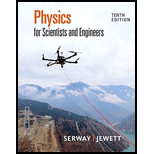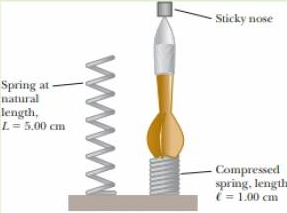
Concept explainers
You are lying in your bedroom, resting after doing your physics homework. As you stare at your ceiling, you come up with the idea for a new game. You grab a dart with a sticky nose and a mass of 19.0 g. You also grab a spring that has been lying on your desk from some previous project. You paint a target pattern on your ceiling. Your new game is to place the spring vertically on the floor, place the sticky-nose dart facing upward on the spring, and push the spring downward until the coils all press together, as on the right in Figure P7.26. You will then release the spring, firing the dart up toward the target on your ceiling, where its sticky nose will make it hang from the ceiling. The spring has an uncompressed end-to-end length of 5.00 cm, as shown on the left in Figure P7.26, and can be compressed to an end-to-end length of 1.00 cm when the coils are all pressed together. Before trying the game, you hold the upper end of the spring in one hand and hang a bundle of ten identical darts from the lower end of the spring. The spring extends by 1.00 cm due to the weight of the darts. You are so excited about the new game that, before doing a test of the game, you run out to gather your friends to show them. When your friends are in your room watching and you show them the first firing of your new game, why are you embarrassed?
Figure P7.26

Want to see the full answer?
Check out a sample textbook solution
Chapter 7 Solutions
Physics:f/sci.+engrs.,ap Ed.
- Frictionless surfarrow_forward71. A 2.1-kg mass is connected to a spring with spring constant 72 k = 150 N/m and unstretched length 18 cm. The two are mounted on a frictionless air table, with the free end of the spring attached to a frictionless pivot. The mass is set into circular mo- tion at 1.4 m/s. Find the radius of its path. cor moving at 77 km/h negotiat CH —what's the minimum icient of frictioarrow_forward12. Two forces act on a 3.1-kg mass that undergoes acceleration = 0.91 0.27 m/s². If one force is -1.2î – 2.5ĵ N, what's the other?arrow_forward
- 36. Example 5.7: You whirl a bucket of water around in a vertical circle of radius 1.22 m. What minimum speed at the top of the circle will keep the water in the bucket?arrow_forwardPassage Problems Laptop computers are equipped with accelerometers that sense when the device is dropped and then put the hard drive into a protective mode. Your computer geek friend has written a program that reads the accel- erometer and calculates the laptop's apparent weight. You're amusing yourself with this program on a long plane flight. Your laptop weighs just 5 pounds, and for a long time that's what the program reports. But then the "Fasten Seatbelt" light comes on as the plane encounters turbu- lence. Figure 4.27 shows the readings for the laptop's apparent weight over a 12-second interval that includes the start of the turbulence. 76. At the first sign of turbulence, the plane's acceleration a. is upward. b. is downward. c. is impossible to tell from the graph. 77. The plane's vertical ac- celeration has its greatest magnitude a. during interval B. b. during interval C. c. during interval D. 78. During interval C, you can conclude for certain that the plane is Apparent…arrow_forwardIf the metal sphere on the Van de Graff has a charge of 0.14 Coulombs and the person has a mass of 62 kg, how much excess charge would the person need in order to levitate at a distance 25 cm from the center of the charged metal sphere? Assume you can treat both the person and the metal sphere as point charges a distance 25 cm from each otherarrow_forward
- If the metal sphere on the Van de Graff has a charge of 0.14 Coulombs and the person has a mass of 62 kg, how much excess charge would the person need in order to levitate at a distance 25 cm from the center of the charged metal sphere? Assume you can treat both the person and the metal sphere as point charges a distance 25 cm from each other (so that you can use Coulomb's Law to calculate the electrical force).arrow_forwardUsing Coulomb's Law, calculate the magnitude of the electrical force between two protons located 1 meter apart from each other. (Give your answer as the number of Newtons but as usual you only need to include the number, not the unit label.)arrow_forwardPart A You want to get an idea of the magnitude of magnetic fields produced by overhead power lines. You estimate that a transmission wire is about 12 m above the ground. The local power company tells you that the line operates at 12 kV and provide a maximum of 60 MW to the local area. Estimate the maximum magnetic field you might experience walking under such a power line, and compare to the Earth's field. [For an ac current, values are rms, and the magnetic field will be changing.] Express your answer using two significant figures. ΟΤΕ ΑΣΦ VAΣ Bmax= Submit Request Answer Part B Compare to the Earth's field of 5.0 x 10-5 T. Express your answer using two significant figures. Ο ΑΣΦ B BEarth ? ? Tarrow_forward
- Ho propel 9-kN t. Boat 27. An elevator accelerates downward at 2.4 m/s². What force does the elevator's floor exert on a 52-kg passenger?arrow_forward16. 17 A CUIN Starting from rest and undergoing constant acceleration, a 940-kg racing car covers 400 m in 4.95 s. Find the force on the car.arrow_forward----- vertical diste Section 4.6 Newton's Third Law 31. What upward gravitational force does a 5600-kg elephant exert on Earth?arrow_forward
 Physics for Scientists and Engineers: Foundations...PhysicsISBN:9781133939146Author:Katz, Debora M.Publisher:Cengage Learning
Physics for Scientists and Engineers: Foundations...PhysicsISBN:9781133939146Author:Katz, Debora M.Publisher:Cengage Learning Principles of Physics: A Calculus-Based TextPhysicsISBN:9781133104261Author:Raymond A. Serway, John W. JewettPublisher:Cengage Learning
Principles of Physics: A Calculus-Based TextPhysicsISBN:9781133104261Author:Raymond A. Serway, John W. JewettPublisher:Cengage Learning Physics for Scientists and Engineers with Modern ...PhysicsISBN:9781337553292Author:Raymond A. Serway, John W. JewettPublisher:Cengage Learning
Physics for Scientists and Engineers with Modern ...PhysicsISBN:9781337553292Author:Raymond A. Serway, John W. JewettPublisher:Cengage Learning Physics for Scientists and Engineers, Technology ...PhysicsISBN:9781305116399Author:Raymond A. Serway, John W. JewettPublisher:Cengage Learning
Physics for Scientists and Engineers, Technology ...PhysicsISBN:9781305116399Author:Raymond A. Serway, John W. JewettPublisher:Cengage Learning College PhysicsPhysicsISBN:9781285737027Author:Raymond A. Serway, Chris VuillePublisher:Cengage Learning
College PhysicsPhysicsISBN:9781285737027Author:Raymond A. Serway, Chris VuillePublisher:Cengage Learning Physics for Scientists and EngineersPhysicsISBN:9781337553278Author:Raymond A. Serway, John W. JewettPublisher:Cengage Learning
Physics for Scientists and EngineersPhysicsISBN:9781337553278Author:Raymond A. Serway, John W. JewettPublisher:Cengage Learning





